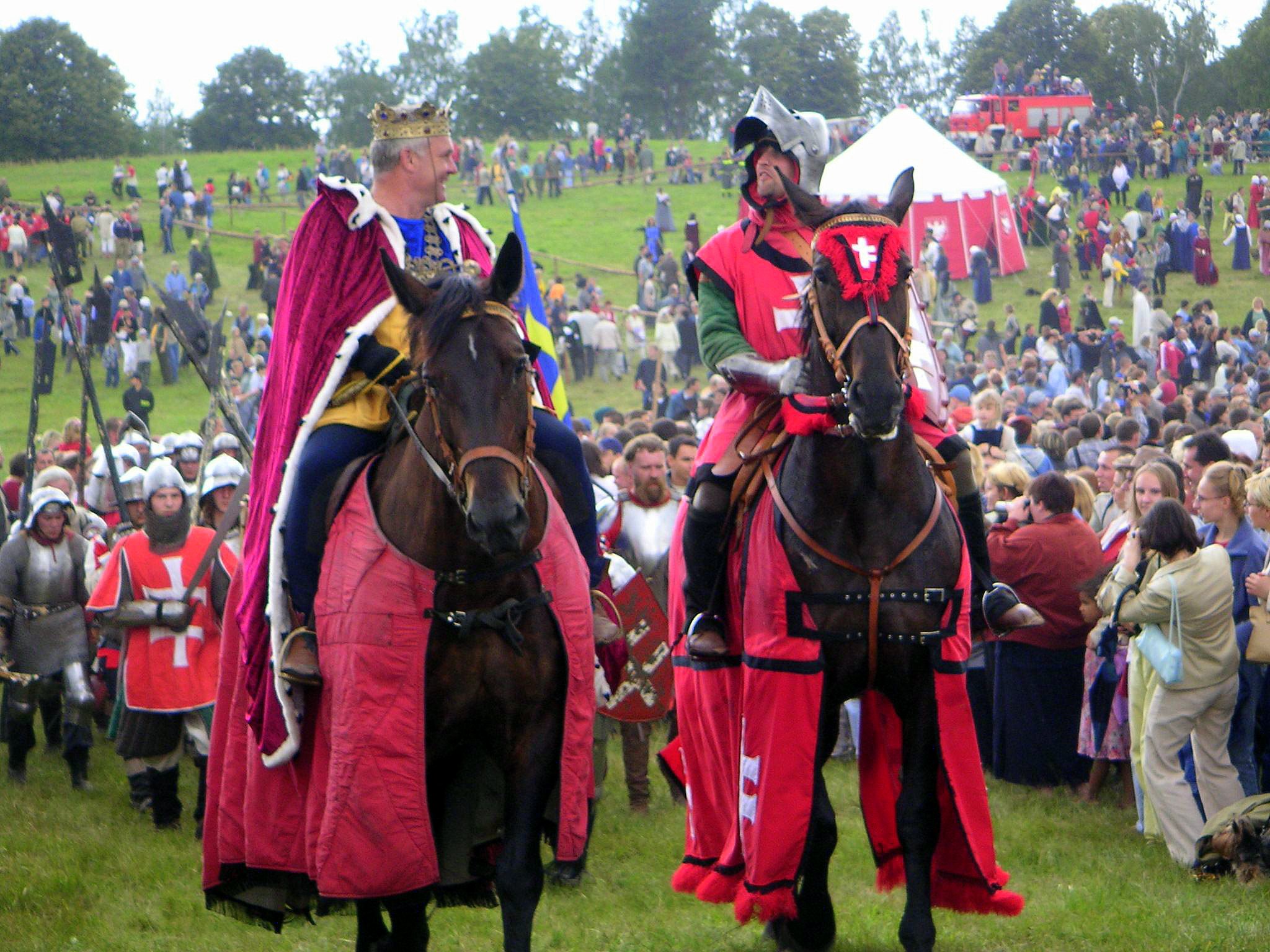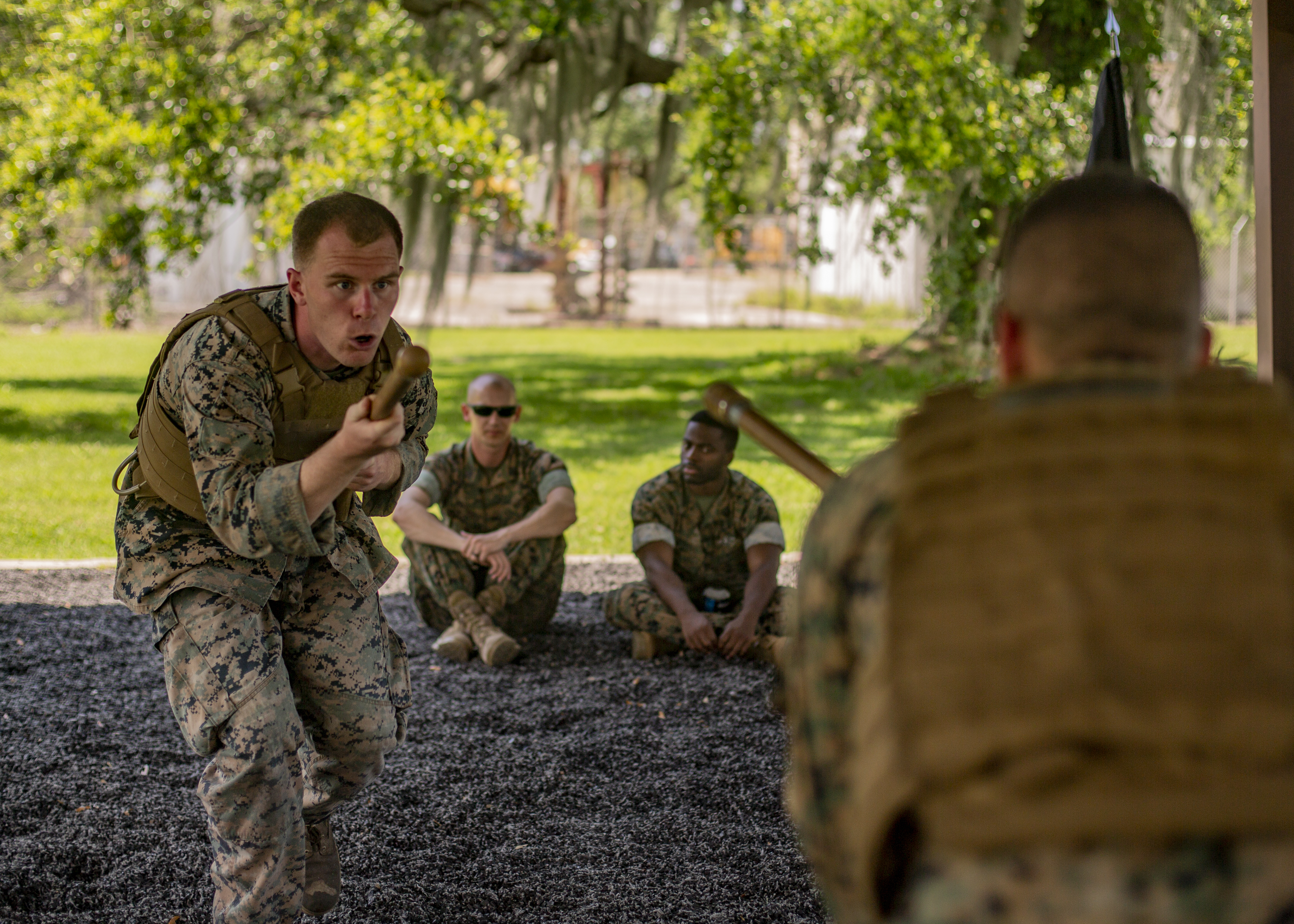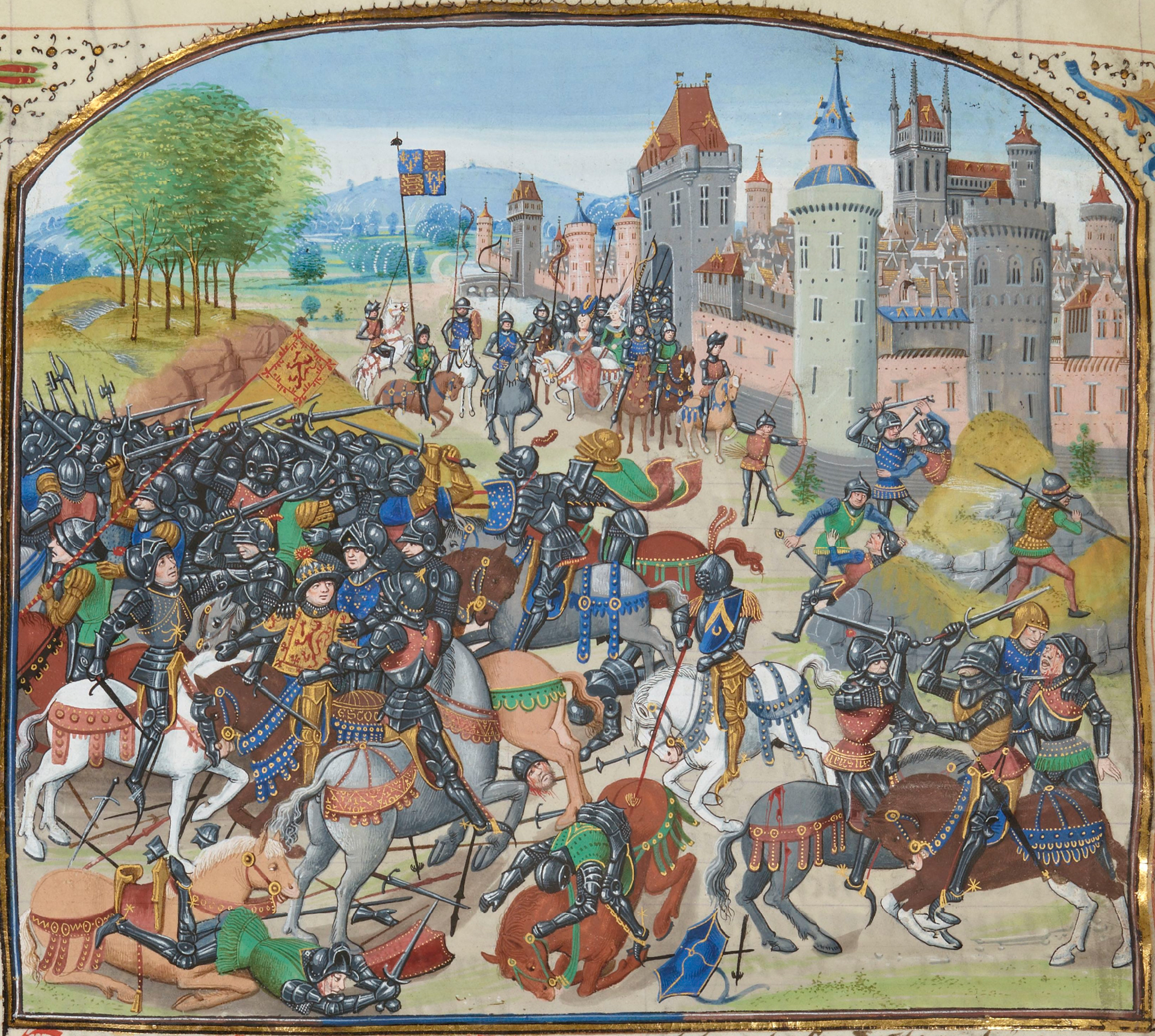|
Medieval Reenactment
Medieval reenactment is a form of historical reenactment that focuses on re-enacting European history of the Middle Ages, broadly the period from the Decline of the Roman Empire to about the end of the 15th century. The first part of this period is sometimes called the Migration Period or Dark Ages by Western European historians, and as Völkerwanderung ("wandering of the peoples") by German historians. This term is usually reserved for the 5th and 6th centuries. Re-enactors who re-create the next period of history – 7th to 11th centuries – often refer to this as the Early Middle Ages. The 12th to 14th centuries fall under the term High medieval, while the 15th century is often termed Late medieval, though usage varies. With such a wide range of eras most medieval reenactment groups focus on a smaller time period, sometimes restricting their interest to a particular century, or even a specific decade, series of battles, or monarch, depending on how authentic the reenactment an ... [...More Info...] [...Related Items...] OR: [Wikipedia] [Google] [Baidu] |
Grunwald 2003
Grunwald may refer to: Places Administrative * Grunwald, Warmian-Masurian Voivodeship, a village in northern Poland ** Gmina Grunwald, a municipality containing the village of Grunwald * Grunwald, Poznań, a district of the city of Poznań in western Poland * Grunwald, Łódź Voivodeship, a village in central Poland Non-administrative * Grunwald Monument (''Pomnik Grunwaldzki''), erected in 1910 in Kraków, Poland * Grunwald Square, Warsaw, an urban square in Warsaw, Poland * ''Grunwald'', a sanatorium in Sokołowsko, Poland *Grunwaldzka street in Bydgoszcz Sports * Grunwald Poznań (sports club), a sports club with many different sections including: ** Grunwald Poznań (field hockey) ** Grunwald Poznań (football) ** Grunwald Poznań (handball) * Grunwald Wilno, the Polish name for a Lithuanian football club Other uses * Grunwald (surname) * Battle of Grunwald, a decisive battle fought in 1410 in what is now northern Poland See also * Greenwald (other) * Žalgiri ... [...More Info...] [...Related Items...] OR: [Wikipedia] [Google] [Baidu] |
Martial Art
Martial arts are codified systems and traditions of combat practiced for a number of reasons such as self-defence; military and law enforcement applications; competition; physical, mental, and spiritual development; entertainment; and the preservation of a nation's intangible cultural heritage. The concept of martial arts was originally associated with East Asian tradition, but subsequently the term has been applied to practices that originated outside that region. Etymology "Martial arts" is a direct English translation of the Sino-Japanese word (, ). Literally, it refers to "武 martial" and "芸 arts". The term ''martial arts'' was popularized by mainstream popular culture during the 1960s to 1970s, notably by Hong Kong martial arts films (most famously those of Bruce Lee) during the so-called " chopsocky" wave of the early 1970s. According to John Clements, the term ''martial arts'' itself is derived from an older Latin term meaning "arts of Mars", the Roman god of w ... [...More Info...] [...Related Items...] OR: [Wikipedia] [Google] [Baidu] |
Staffage
In painting, staffage () are the human and animal figures depicted in a scene, especially a landscape A landscape is the visible features of an area of land, its landforms, and how they integrate with natural or human-made features, often considered in terms of their aesthetic appeal.''New Oxford American Dictionary''. A landscape includes th ..., that are not the primary subject matter of the work. Typically they are small, and there to add an indication of scale and add interest. Before the adoption of the word into the visual arts in the late eighteenth and early nineteenth centuries, ''Staffage'' in German language, German could mean "accessories" or "decoration". The word can be used in two senses: as a general term for any figures in a work, even when they are, at least ostensibly, the main subject, and as a descriptive term for figures to whom no specific identity or story is attached, included merely for compositional or decorative reasons. In the latter sense, st ... [...More Info...] [...Related Items...] OR: [Wikipedia] [Google] [Baidu] |
Authenticity (reenactment)
In historical reenactment, authenticity (sometimes referred to as the A-factor or simply A) is a measure of how close an item, prop, action, weapon, tactic, or custom is to what would actually have been used or done in the time period being depicted. For example, in most northern European medieval reenactment cotton is an ''inauthentic'' material—as opposed to wool or linen—though it would be ''authentic'' in more modern periods and events, such as American Civil War reenactment or World War II reenactment. Likewise, pop culture references and talking about modern events or objects (e.g., wrist watches, mobile phones, or contemporary politicians) is inauthentic. Generally, the ratio of events and groups enforcing strict authenticity to those permitting (limited) in authenticity among the participating reenactors is estimated to be half-and-half, i.e., there are approximately as many groups enforcing historical accuracy as there are permitting a more liberal use of t ... [...More Info...] [...Related Items...] OR: [Wikipedia] [Google] [Baidu] |
Schloss Kaltenberg
The Schloss Kaltenberg is a castle in the village of Geltendorf in Upper Bavaria, Germany. The castle was built in 1292 and is currently under the proprietorship of Prince Luitpold of Bavaria (b.1951), Prince Luitpold of Bavaria, the great-grandson of the last king of Bavaria, Ludwig III. History *1292 the castle is built by Rudolf I, Duke of Bavaria *1320 the castle is destroyed during a family feud *1425 the castle is rebuilt by the Augsburger Patrician Peter Rehlinger *1468 sold to the house of Hundt zu Lautterbach *1514 the historian Wiguläus Hundt was born in the castle *1612 the castle is assumed by the Jesuits *1633 during the Thirty Years' War the Sweden, Swedish destroy the castle *1781 the Knights Hospitaller, Knights of Malta assume ownership *1870 a brewery is founded and the castle was renovated in the neo-Gothic style, which remains to the present *1900 the painter Lorenzo Quaglio assumes ownership. Quaglio lived in the Castle and made many paintings of the Castle ... [...More Info...] [...Related Items...] OR: [Wikipedia] [Google] [Baidu] |
Bretten
Bretten (; South Franconian: ''Bredde'') is a town in the state of Baden-Württemberg, Germany. It is located on Bertha Benz Memorial Route. Geography Bretten lies in the centre of a rectangle that is formed by Heidelberg, Karlsruhe, Heilbronn and Stuttgart as corners. It has a population of approximately 28,000. The centre of Bretten consists of many old half-timbered houses around a lively marketplace. Towns and villages under the administration of Bretten include Bauerbach, Büchig, Diedelsheim, Dürrenbüchig, Gölshausen, Neibsheim, Rinklingen, Ruit and Sprantal. History Bretten was first mentioned as "villa breteheim" in the " Lorsch codex" in 767. Since 1148 Bretten had the right to mint and issue coins. In 1254 Bretten received city rights. In 1492 Bretten was granted to hold four fairs by Pfalzgraf Philipp. Philipp Melanchthon was born in Bretten in 1497. The residents of Bretten successfully sallied against the Swabian besiegers around Ulrich of Württemberg in 150 ... [...More Info...] [...Related Items...] OR: [Wikipedia] [Google] [Baidu] |
Hundred Years War
The Hundred Years' War (; 1337–1453) was a conflict between the kingdoms of England and France and a civil war in France during the Late Middle Ages. It emerged from feudal disputes over the Duchy of Aquitaine and was triggered by a claim to the French throne made by Edward III of England. The war grew into a broader military, economic, and political struggle involving factions from across Western Europe, fuelled by emerging nationalism on both sides. The periodisation of the war typically charts it as taking place over 116 years. However, it was an intermittent conflict which was frequently interrupted by external factors, such as the Black Death, and several years of truces. The Hundred Years' War was a significant conflict in the Middle Ages. During the war, five generations of kings from two rival dynasties fought for the throne of France, then the wealthiest and most populous kingdom in Western Europe. The war had a lasting effect on European history: both sides p ... [...More Info...] [...Related Items...] OR: [Wikipedia] [Google] [Baidu] |
Battle Of Agincourt
The Battle of Agincourt ( ; ) was an English victory in the Hundred Years' War. It took place on 25 October 1415 (Saint Crispin's Day) near Azincourt, in northern France. The unexpected victory of the vastly outnumbered English troops against the numerically superior French army boosted English morale and prestige, crippled France, and started a new period of English dominance in the war that would last for 14 years until England was defeated by France in 1429 during the Siege of Orléans. After several decades of relative peace, the English had Hundred Years' War (1415–53), resumed the war in 1415 amid the failure of negotiations with the French. In the ensuing campaign, many soldiers died from disease, and the English numbers dwindled; they tried to withdraw to Pale of Calais, English-held Calais but found their path blocked by a considerably larger French army. Despite the numerical disadvantage, the battle ended in an overwhelming victory for the English. King Henry V ... [...More Info...] [...Related Items...] OR: [Wikipedia] [Google] [Baidu] |
Middelaldercentret
Middelaldercentret () is an experimental living history archaeological open-air museum in Denmark, which depicts the Middle Ages in the Denmark of the late 14th and early 15th centuries. It is located in Sundby Lolland, some 4 km northwest of the centre of Nykøbing Falster on the waterfront of Guldborgsund. It features a town built as part of a typical Danish market town with craftsmen, a harbour with ships and boats, and a market place. The employees are dressed in period costumes and live and work in the houses and do everyday activities such as craftmanship, cooking and weapon training. Furthermore, the museum has a variety of siege weapons of the period, such as trebuchets, a ballista and a cannon and smaller weapons such as handguns, longbows and crossbows. All of the items are built on site using period tools. Activities include live firing of the weapons daily, archery, knightly tournaments, and demonstrations of crafts and tasks from the late 14th century and ear ... [...More Info...] [...Related Items...] OR: [Wikipedia] [Google] [Baidu] |
Open Air Museum
An open-air museum is a museum that exhibits collections of buildings and artifacts outdoors. It is also frequently known as a museum of buildings or a folk museum. Definition Open air is "the unconfined atmosphere ... outside buildings". In the loosest sense, an open-air museum is any institution that includes one or more buildings in its collections, including farm museums, historic house museums, and archaeological open-air museums. Mostly, "open-air museum" is applied to a museum that specializes in the collection and re-erection of multiple old buildings at large outdoor sites, usually in settings of recreated landscapes of the past, and often including living history. Such institutions may, therefore, be described as building museums. European open-air museums tended to be sited originally in regions where wooden architecture prevailed, as wooden structures may be translocated without substantial loss of authenticity. Common to all open-air museums, including the earl ... [...More Info...] [...Related Items...] OR: [Wikipedia] [Google] [Baidu] |
Louis De Gruuthuse
Louis de Bruges, Lord of Gruuthuse, Prince of Steenhuijs, Earl of Winchester ( Dutch: Lodewijk van Brugge; – 24 November 1492), was a Flemish courtier, bibliophile, soldier and nobleman. He was awarded the title of Earl of Winchester by King Edward IV of England in 1472, and was Stadtholder of Holland and Zeeland 1462–77. Early life Born in 1427 as the legitimate son of Lord Jean IV of Bruges of the Gruuthuse family, and Margriet of Steenhuyse, Lady of Avelghem, young Loys (Louis or Ludovicus) was trained in the arts of war and the court in the wealth and luxury of Flanders' Golden Age. Louis de Gruuthuse took part in the Tournament of the White Bear in 1443, 1444, 1447, 1448 and 1450, where he often won one of the prizes. This caught the eye of the Duke of Burgundy and Count of Flanders, Philip the Good (1396–1467), who made Louis his squire and official wine server, an honorary title bestowed on only a few selected men. As a courtier Louis followed the Duke around ... [...More Info...] [...Related Items...] OR: [Wikipedia] [Google] [Baidu] |
Eglinton Tournament Of 1839
The Eglinton Tournament of 1839 was a reenactment of a medieval joust and revel held in North Ayrshire, Scotland between 28 and 30 August. It was funded and organized by Archibald, Earl of Eglinton, and took place at Eglinton Castle in Ayrshire. The Queen of Beauty was Georgiana, Duchess of Somerset. Many distinguished visitors took part, including Prince Louis Napoleon, the future Emperor of the French. The Tournament was a deliberate act of Romanticism, and drew 100,000 spectators. It is primarily known now for the ridicule poured on it by the Whigs. Problems were caused by rainstorms. At the time views were mixed Whatever opinion may be formed of the success of the Tournament, as an imitation of ancient manners and customs, we heard only one feeling of admiration expressed at the gorgeousness of the whole scene, considered only as a pageant. Even on Wednesday, when the procession was seen to the greatest possible disadvantage, the dullest eye glistened with delight as th ... [...More Info...] [...Related Items...] OR: [Wikipedia] [Google] [Baidu] |







